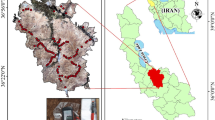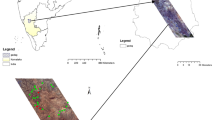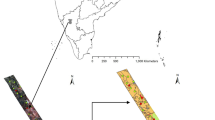Abstract
Texture is one of the most important soil properties that knowledge of the spatial distribution is essential for land-use planning and other activities related to agriculture and environment protection. So, this study was performed to supply the soil texture spatial distribution using standardized spectral reflectance (ZPC1) index of Landsat 8 satellite images in the northwest of Iran. The soil sampling was performed using a random method in 145 points. Mineral soil particles including clay, silt, and sand were determined, and soil texture was calculated. In this study, Landsat 8 satellite images were used to interpolate the soil texture spatial distribution. In the first step, the principal component analysis (PCA) was obtained. Then, PCA1 was standardized using a z-score (ZPC1), and regression techniques were used to create proper relationships between ZPC1 and the primary soil particles. Then, spatial distribution of soil particles was used to create a spatially distributed map of the soil textural classes. The results showed that the standardization of the first component reduced the standard deviation of PCA1 from 23.6 to 10.8. The results of comparing ZPC1 with soil mineral components showed that with increasing the amounts of soil clay and sand, the ZPC1 value decreases and increases, respectively. The results showed that the ranges of the spatial distribution of clay and sand were similar to the laboratory-measured amounts. The results of texture class prediction using the soil texture triangle showed that the amount of similarity between the measured and predicted classes was 53.79%.













Similar content being viewed by others
Data availability
The datasets generated during and/or analyzed during the current study are available from the corresponding author on reasonable request. The data of satellite images of Landsat 8 are available in the earth explorer website (https://earthexplorer.usgs.gov/).
References
Adhikari, K., Kheir, R. B., Greve, M. B., Bøcher, P. K., Malone, B. P., Minasny, B., et al. (2013). High-resolution 3-D mapping of soil texture in Denmark. Soil Science Society of America Journal, 77(3), 860–876.
Akpa, S. I., Odeh, I. O., Bishop, T. F., & Hartemink, A. E. (2014). Digital mapping of soil particle-size fractions for Nigeria. Soil Science Society of America Journal, 78(6), 1953–1966.
Bellon-Maurel, V., Fernandez-Ahumada, E., Palagos, B., Roger, J. M., & McBratney, A. (2010). Critical review of chemometric indicators commonly used for assessing the quality of the prediction of soil attributes by NIR spectroscopy. TrAC Trends in Analytical Chemistry, 29(9), 1073–1081.
Benedet, L., Faria, W. M., Silva, S. H. G., Mancini, M., Demattê, J. A. M., Guilherme, L. R. G., & Curi, N. (2020). Soil texture prediction using portable X-ray fluorescence spectrometry and visible near-infrared diffuse reflectance spectroscopy. Geoderma, 376(3), 541–553.
Bishop, T., & McBratney, A. (2001). A comparison of prediction methods for the creation of field-extent soil property maps. Geoderma, 103(1–2), 149–160.
Bousbih , S., Zribi, M., Pelletier, C., Gorrab, A., Lili-Chabaane, Z., Baghdadi, N., Ben Aissa, N., Mougenot, B. (2019). Soil texture estimation using radar and optical data from sentinel-1 and sentinel-2. Remote Sensing, 1(13), 5–20.
Bouyoucos, G. J. (1962). Hydrometer method improved for making particle size analyses of soils 1. Agronomy Journal, 54(5), 464–465.
Broge, N. H., Thomsen, A. G., & Greve, M. H. (2004). Prediction of topsoil organic matter and clay content from measurements of spectral reflectance and electrical conductivity. Acta Agriculturae Scandinavica, Section B-Soil & Plant Science, 54(4), 232–240.
Carvalho Junior, W., Lagacherie, P., da Silva, C. C., Calderano Filho, B., & Bhering, S. B. (2014). A regional-scale assessment of digital mapping of soil attributes in a tropical hillslope environment. Geoderma, 23(2), 479–486.
Castaldi, F., Palombo, A., Santini, F., Pascucci, S., Pignatti, S., & Casa, R. (2016). Evaluation of the potential of the current and forthcoming multispectral and hyperspectral imagers to estimate soil texture and organic carbon. Remote Sensing of Environment, 179, 54–65.
Coleman, T., Agbu, P., Montgomery, O., Gao, T., & Prasad, S. (1991). Spectral band selection for quantifying selected properties in highly weathered soils. Soil Science, 151(5), 355–361.
da Silva, C. C., de Carvalho, J. W., Bhering, S. B., & Calderano, F. B. (2016). Spatial prediction of soil surface texture in a semiarid region using random forest and multiple linear regressions. Catena, 139, 232–240.
D’acqui, L., Pucci, A., & Janik , L. (2010). Soil properties prediction of western Mediterranean islands with similar climatic environments by means of mid-infrared diffuse reflectance spectroscopy. European Journal of Soil Science, 61(6), 865–876.
Demattê, J. A., Campos, R. C., Alves, M. C., Fiorio, P. R., & Nanni, M. R. (2004). Visible–NIR reflectance: a new approach on soil evaluation. Geoderma, 121(1–2), 95–112.
Gholizadeh, A., Amin, M., Borůvka, L., & Saberioon, M. (2014). Models for estimating the physical properties of paddy soil using visible and near infrared reflectance spectroscopy. Journal of Applied Spectroscopy, 81, 534–540.
Gholizadeh, A., Žižala, D., Saberioon, M., & Borůvka, L. (2018). Soil organic carbon and texture retrieving and mapping using proximal, airborne and Sentinel-2 spectral imaging. Remote Sensing of Environment, 218, 89–103.
Guide EUs. (2008). ENVI on-line software user’s manual. ITT Visual Information Solutions.
Higgins, S., Schellberg, J., & Bailey, J. (2019). Improving productivity and increasing the efficiency of soil nutrient management on grassland farms in the UK and Ireland using precision agriculture technology. European Journal of Agronomy, 106, 67–74.
Hong, Y., Chen, S., Zhang, Y., Chen, Y., Yu, L., Liu, Y., et al. (2018). Rapid identification of soil organic matter level via visible and near-infrared spectroscopy: effects of two-dimensional correlation coefficient and extreme learning machine. Science of the Total Environment, 644, 1232–1243.
Iranian soil and water institute. (1991). Iranian soil map (1:1000.000), http://www.swri.ir/
Islam, K., Singh, B., & McBratney, A. (2003). Simultaneous estimation of several soil properties by ultra-violet, visible, and near-infrared reflectance spectroscopy. Soil Research, 416, 1101–1114.
Jaconi, A., Vos, C., & Don, A. (2019). Near infrared spectroscopy as an easy and precise method to estimate soil texture. Geoderma, 337, 906–913.
Jensen, J. R. (1996). Introductory digital image processing: a remote sensing perspective. vol Ed. 2. Prentice-Hall Inc. & Nbsp. https://doi.org/10.1080/10106048709354084
Ji, W., Adamchuk, V. I., Chen, S., Su, A. S. M., Ismail, A., Gan, Q., et al. (2019). Simultaneous measurement of multiple soil properties through proximal sensor data fusion: a case study. Geoderma, 341, 111–128.
Jin, X., Li, Z., Yang, G., Yang, H., Feng, H., Xu, X., et al. (2017). Winter wheat yield estimation based on multi-source medium resolution optical and radar imaging data and the AquaCrop model using the particle swarm optimization algorithm. ISPRS Journal of Photogrammetry and Remote Sensing, 126, 24–37.
Lagacherie, P., Baret, F., Feret, J. B., Netto, J. M., & Robbez-Masson, J. M. (2008). Estimation of soil clay and calcium carbonate using laboratory, field and airborne hyperspectral measurements. Remote Sensing of Environment, 112, 825–835.
Levi, M. R., & Rasmussen, C. (2014). Covariate selection with iterative principal component analysis for predicting physical soil properties. Geoderma, 219, 46–57.
Li, A. D., Guo, P. T., Wu, W., & Liu, H. B. (2017). Impacts of terrain attributes and human activities on soil texture class variations in hilly areas, south-west China. Environmental Monitoring and Assessment, 189(6), 281–292.
Li, X., Liu, J., Zhang, J., Wang, W., & Xin, W. (2014). Soil texture distribution simulation and risk assessment using transition probability-based geostatistics. International Agrophysics, 28(4), 141–153.
Liao, K., Xu, S., Wu, J., & Zhu, Q. (2013). Spatial estimation of surface soil texture using remote sensing data. Soil Science and Plant Nutrition, 59(4), 488–500.
Lillesand, T., Kiefer, R. W., Chipman, J. (2015). Remote sensing and image interpretation. John Wiley & Sons. 7th Edition. 736 pages. ISBN: 978–1–118–34328–9.
Lobell, D. B., & Asner, G. P. (2002). Moisture effects on soil reflectance. Soil Science Society of America Journal, 66(3), 722–727.
Menut, L., Pérez, C., Haustein, K., Bessagnet, B., Prigent, C., & Alfaro, S. (2013). Impact of surface roughness and soil texture on mineral dust emission fluxes modeling. Journal of Geophysical Research: Atmospheres, 118(12), 6505–6520.
Mondejar, J. P., & Tongco, A. F. (2019). Estimating topsoil texture fractions by digital soil mapping-a response to the long outdated soil map in the Philippines. Sustainable Environment Research, 29(1), 31–45.
Mulder, V., De Bruin, S., Schaepman, M. E., & Mayr, T. (2011). The use of remote sensing in soil and terrain mapping—a review. Geoderma, 162(1–2), 1–19.
Odeh, I. O., & McBratney, A. B. (2000). Using AVHRR images for spatial prediction of clay content in the lower Namoi Valley of eastern Australia. Geoderma, 97(3–4), 237–254.
Page, A., Miller, R., & Keeney, D. (1992). Methods of soil analysis. ASA. SSSA Publishers.
Rossel, R. V., Walvoort, D., McBratney, A., Janik, L. J., & Skjemstad, J. (2006). Visible, near infrared, mid infrared or combined diffuse reflectance spectroscopy for simultaneous assessment of various soil properties. Geoderma, 131(1–2), 59–75.
Schowengerdt, R. A. (2012). Techniques for image processing and classifications in remote sensing. Academic Press, 249 pages. ISBN: 9780323138550.
Shabou, M., Mougenot, B., Chabaane, Z. L., Walter, C., Boulet, G., Aissa, N. B., & Zribi, M. (2015). Soil clay content mapping using a time series of Landsat TM data in semi-arid lands. Remote Sensing, 7(5), 6059–6078.
Shahriari, M., Delbari, M., Afrasiab, P., & Pahlavan-Rad, M. R. (2019). Predicting regional spatial distribution of soil texture in floodplains using remote sensing data: a case of southeastern Iran. Catena, 182, 134–149.
Silva, S. H. G., Weindorf, D. C., Pinto, L. C., Faria, W. M., Junior, F. W. A., Gomide, L. R., et al. (2020). Soil texture prediction in tropical soils: a portable x-ray fluorescence spectrometry approach. Geoderma, 362, 114–136.
Tümsavaş, Z., Tekin, Y., Ulusoy, Y., & Mouazen, A. M. (2019). Prediction and mapping of soil clay and sand contents using visible and near-infrared spectroscopy. Biosystems Engineering, 177, 90–100.
Vaudour, E., Gomez, C., Fouad, Y., & Lagacherie, P. (2019). Sentinel-2 image capacities to predict common topsoil properties of temperate and Mediterranean agroecosystems. Remote Sensing of Environment, 223, 21–33.
Vincent, R. K. (1997). Fundamentals of geological and environmental remote sensing. Prentice Hall Upper Saddle River. NJ, Vol 366.
Wang, S., Jin, X., Adhikari, K., Li, W., Yu, M., Bian, Z., & Wang, Q. (2018). Mapping total soil nitrogen from a site in northeastern China. Catena, 166, 134–146.
Weindorf, D. C., Bakr, N., & Zhu, Y. (2014). Advances in portable x-ray fluorescence (PXRF) for environmental, pedological, and agronomic applications. Advances in Agronomy, 128(1), 1–45.
Wetterlind, J., & Stenberg, B. (2010). Near-infrared spectroscopy for within-field soil characterization: small local calibrations compared with national libraries spiked with local samples. European Journal of Soil Science, 61(6), 823–843.
Yang, S., Wang, M., & Jiao, L. (2012). Fusion of multispectral and panchromatic images based on support value transform and adaptive principal component analysis. Information Fusion, 13(3), 177–184.
Zhang, Z., Ding, J., Wang, J., & Ge, X. (2020). Prediction of soil organic matter in northwestern China using fractional-order derivative spectroscopy and modified normalized difference indices. Catena, 185(1), 241–257.
Acknowledgements
The authors of this article would like to thank the soil laboratory of ROZH located in Saqqez city, Kurdistan province of Iran, for collecting, sampling, and analyzing the samples and accepting all expenses of this study.
Author information
Authors and Affiliations
Corresponding authors
Additional information
Publisher's Note
Springer Nature remains neutral with regard to jurisdictional claims in published maps and institutional affiliations.
Rights and permissions
About this article
Cite this article
Khosravi Aqdam, K., Miran, N., Mohammadi Khajelou, Y. et al. Predicting the spatial distribution of soil mineral particles using OLI sensor in northwest of Iran. Environ Monit Assess 193, 377 (2021). https://doi.org/10.1007/s10661-021-09163-2
Received:
Accepted:
Published:
DOI: https://doi.org/10.1007/s10661-021-09163-2




